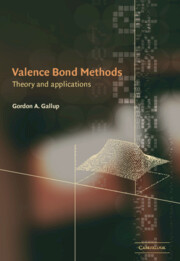Book contents
- Frontmatter
- Contents
- Preface
- List of abbreviations
- I Theory and two-electron systems
- II Examples and interpretations
- 9 Selection of structures and arrangement of bases
- 10 Four simple three-electron systems
- 11 Second row homonuclear diatomics
- 12 Second row heteronuclear diatomics
- 13 Methane, ethane and hybridization
- 14 Rings of hydrogen atoms
- 15 Aromatic compounds
- 16 Interaction of molecular fragments
- References
- Index
13 - Methane, ethane and hybridization
Published online by Cambridge University Press: 13 August 2009
- Frontmatter
- Contents
- Preface
- List of abbreviations
- I Theory and two-electron systems
- II Examples and interpretations
- 9 Selection of structures and arrangement of bases
- 10 Four simple three-electron systems
- 11 Second row homonuclear diatomics
- 12 Second row heteronuclear diatomics
- 13 Methane, ethane and hybridization
- 14 Rings of hydrogen atoms
- 15 Aromatic compounds
- 16 Interaction of molecular fragments
- References
- Index
Summary
In Chapter 11 we discussed the properties of the atoms in the second row of the periodic table and how these might influence molecules formed from them. We focus on carbon in this chapter and examine how the bonding changes through the series CH, CH2, CH3, and CH4. The first three of these are known only spectroscopically, in matrix isolation, or as reaction intermediates, but many of their properties have been determined. The reader will recall that carbon exhibits relatively low-energy excited valence configurations. For carbon the excitation energy is around 4 eV, and among the atoms discussed in Chapter 11, only boron has a lower excitation energy. If this excited configuration is to have an important role in the bonding, the energy to produce the excitation must be paid back by the energy of formation of the bond or bonds. We shall see that VB theory predicts this happens between CH and CH2. After our discussion of these single carbon compounds, we will consider ethane, CH3CH3, as an example for dealing with larger hydrocarbons.
CH, CH2, CH3, and CH4
STO3G basis
We first give calculations of these four molecules with an STO3G basis. The total energies and first bond dissociation energies are collected in Table 13.1. We see that, even with the minimal basis, the bond energies are within 0.4eV of the experimental values except for CH3, which has considerable uncertainty. The calculated values tend to be smaller, as expected for a minimal VB treatment.
Information
- Type
- Chapter
- Information
- Valence Bond MethodsTheory and Applications, pp. 177 - 190Publisher: Cambridge University PressPrint publication year: 2002
